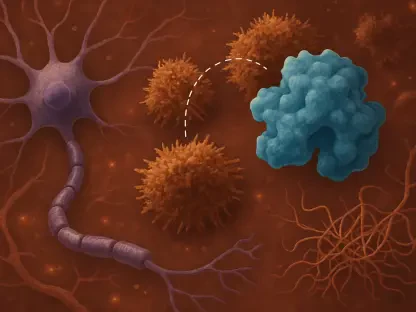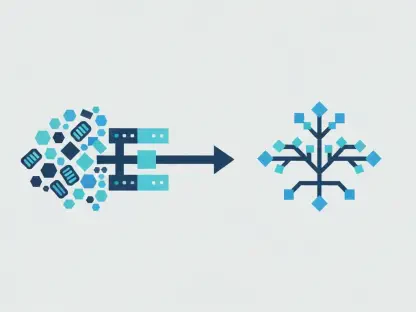Imagine a future where therapies for devastating diseases like cancer, diabetes, or infectious outbreaks can be developed at an unprecedented pace, saving countless lives with tailored precision. Researchers at the Massachusetts Institute of Technology (MIT) are turning this vision into reality by leveraging artificial intelligence (AI) to overhaul the design of lipid nanoparticles (LNPs) for RNA therapies. These tiny carriers are essential for delivering fragile RNA molecules, such as messenger RNA (mRNA), into cells, a cornerstone of modern treatments like COVID-19 vaccines. Yet, crafting the ideal nanoparticle has long been a slow, arduous process due to the sheer number of possible component combinations. Under the leadership of Associate Professor Giovanni Traverso, the MIT team has introduced a transformative solution that could redefine drug delivery. Their AI-driven approach not only accelerates development but also enhances the effectiveness of RNA-based solutions, opening doors to groundbreaking medical advancements.
Transforming Drug Delivery with AI
Overcoming Traditional Design Challenges
The integration of AI into nanoparticle design represents a seismic shift in addressing the inefficiencies that have plagued traditional methods for decades. Developing LNPs typically involves testing thousands of formulations through painstaking trial and error, a process that can stretch over years. The MIT team’s machine-learning model, named COMET, draws inspiration from transformer architectures similar to those powering advanced language models. By analyzing a vast dataset of around 3,000 LNP compositions, COMET predicts optimal designs with remarkable accuracy. This slashes the need for exhaustive lab experiments, allowing researchers to focus on refining promising candidates. The potential to streamline such a critical aspect of drug delivery cannot be overstated, as it paves the way for faster responses to emerging health crises and chronic conditions alike, fundamentally altering the timeline of therapeutic innovation.
AI’s role extends beyond mere speed, offering a depth of insight that manual processes cannot match. Unlike standard AI tools that optimize single compounds, COMET is uniquely equipped to handle the multi-component nature of LNPs, which include cholesterol, a helper lipid, an ionizable lipid, and a polyethylene glycol (PEG)-linked lipid. Its ability to evaluate intricate combinations ensures a comprehensive approach to design, identifying synergies between ingredients that might otherwise be overlooked. Furthermore, the model has demonstrated its prowess by incorporating additional materials like branched poly beta amino esters (PBAEs), enhancing delivery efficiency. This adaptability sets a new benchmark for nanoparticle engineering, promising formulations that are not only effective but also tailored to specific therapeutic needs, marking a significant leap forward in precision medicine.
Accelerating Development Timelines
The efficiency brought by AI-driven design is a game-changer for the biomedical field, where time often dictates the difference between life and death. By training on extensive libraries of LNP formulations, COMET eliminates much of the guesswork inherent in traditional research, predicting compositions that outperform existing standards. In lab tests on mouse skin cells, the model’s formulations showed superior mRNA delivery compared to some commercially available options, as evidenced by heightened expression of a fluorescent protein. Such results validate the practical utility of AI, offering a glimpse into how quickly new therapies could reach patients. This rapid turnaround is especially crucial for RNA vaccines, where swift development can curb pandemics before they spiral out of control, reshaping public health strategies.
Beyond immediate outcomes, the accelerated pace enabled by COMET has broader implications for resource allocation in research. Laboratories can redirect time and funding from repetitive testing to exploring novel applications or scaling up production of successful formulations. This efficiency also democratizes innovation, potentially allowing smaller research entities with limited budgets to compete in developing cutting-edge therapies. Supported by initiatives like the U.S. Advanced Research Projects Agency for Health (ARPA-H), projects under Traverso’s guidance exemplify how AI can optimize not just technical processes but also the ecosystem of medical advancement. The ripple effects of this technology could lead to a future where life-saving treatments are developed and deployed with unprecedented speed, addressing global health challenges more effectively than ever before.
Unlocking New Possibilities for RNA Therapies
Enhancing Treatment Efficacy and Precision
One of the most promising aspects of AI-optimized LNPs lies in their potential to significantly boost the efficacy of RNA therapies across a spectrum of diseases. Effective delivery of mRNA into target cells is a critical hurdle, as RNA is notoriously fragile and prone to degradation. COMET’s predictions have yielded nanoparticles that excel in protecting and transporting RNA, outperforming some commercial formulations in controlled experiments. This heightened efficiency could translate into stronger immune responses for vaccines, requiring lower doses and minimizing side effects. For patients battling conditions like infectious diseases or cancer, such advancements mean therapies that are not only more potent but also gentler on the body, aligning with the ultimate goal of improving quality of life through medical innovation.
Equally transformative is the model’s capacity to tailor LNPs for specific cell types, heralding a new era of personalized medicine. By training COMET to focus on cells like Caco-2, derived from colorectal cancer, researchers can design nanoparticles that deliver RNA with pinpoint accuracy to affected tissues. This specificity reduces off-target effects, a common challenge in drug delivery, and enhances therapeutic outcomes for complex diseases. The implications extend to chronic conditions as well, where targeted delivery could optimize treatments for diabetes or obesity by ensuring RNA reaches the intended metabolic pathways. As a result, patients might experience more effective interventions with fewer complications, underscoring AI’s potential to customize healthcare solutions to individual biological needs in ways previously unimaginable.
Tackling Real-World Application Barriers
Practical challenges in deploying RNA therapies, such as storage and administration, are also being addressed through AI-driven innovation. One significant obstacle is the instability of LNPs, which often require stringent cold-chain conditions to remain viable. COMET has shown promise in predicting formulations that withstand lyophilization, a freeze-drying process that extends shelf life and eases distribution logistics. This capability is vital for ensuring therapies reach remote or resource-limited regions, where maintaining ultra-low temperatures is often unfeasible. By enhancing stability, AI helps bridge gaps in global healthcare access, making RNA-based treatments a viable option for diverse populations and addressing disparities in medical resource availability.
Another frontier being explored is the development of non-invasive delivery methods, a priority for Traverso’s lab with backing from ARPA-H. Current RNA therapies, such as those mimicking GLP-1 for diabetes management, typically rely on injections, which can deter patient compliance. AI is paving the way for oral delivery systems by optimizing LNPs to survive the harsh gastrointestinal environment and still deliver RNA effectively. Such a breakthrough would revolutionize treatment accessibility, transforming how chronic conditions are managed by eliminating the need for needles. This focus on user-friendly administration reflects a holistic approach to therapy design, ensuring that innovations are not only scientifically sound but also practical for everyday use, ultimately benefiting a wider range of patients.
Envisioning the Broader Impact on Healthcare
Reflecting on a Paradigm Shift
Looking back, the strides made by the MIT team in integrating AI into nanoparticle design marked a turning point in biomedical research. Their development of the COMET model, trained on thousands of LNP formulations, provided a robust tool that predicted superior compositions and adapted to diverse therapeutic challenges. Whether tailoring delivery to specific cell types or enhancing stability for storage, the technology demonstrated unparalleled versatility. Supported by entities like ARPA-H, the work led by Traverso and his colleagues set a high standard for how computational tools could address longstanding barriers in drug delivery, reflecting a profound shift toward data-driven healthcare solutions.
Building Toward Future Innovations
As the field moves forward, the next steps involve scaling these AI-driven insights into clinical applications, ensuring that optimized LNPs translate into tangible patient benefits. Continued research should prioritize rigorous testing across varied conditions and populations to validate efficacy and safety. Collaboration between tech experts and medical professionals will be key to refining models like COMET for even broader uses, potentially extending to other nucleic acid therapies. Additionally, investment in infrastructure for scalable production and distribution of AI-designed nanoparticles could accelerate their integration into mainstream medicine. These efforts promise to solidify AI’s role as a cornerstone of future therapeutic development, driving a new wave of precision and accessibility in global health.









